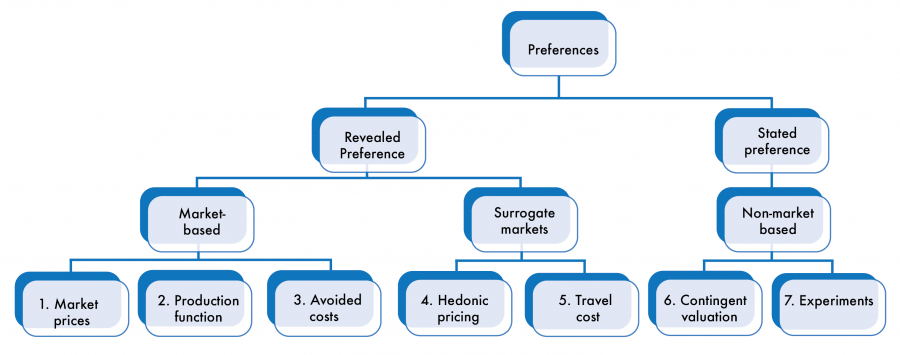Environmental benefits and costs are often expressed in monetary terms. Economic valuation methods are used to derive monetary values. It is useful for environmental researchers to understand these methods, the data they use, their limitations, and how monetary values should be interpreted and applied.
- Understand why monetary environmental benefit estimates are used in decision making and public discourse
- Learn to interpret what monetary valuations represent and what they don’t represent
- Develop basic knowledge of various valuation methods and the data they use
Have participants read one or both of these articles:
1. Putting a Price Tag on Nature's Defenses
Zimmer, Carl. “Putting a Price Tag on Nature’s Defenses.” The New York Times. June 5, 2014. https://www.nytimes.com/2014/06/05/science/earth/putting-a-price-tag-on-natures-defenses.html.
2. Pandanomics: What Is Giant Panda Conservation Worth? Billions Every Year
GrrlScientist. “Pandanomics: What Is Giant Panda Conservation Worth? Billions Every Year.” Forbes. June 29, 2018. https://www.forbes.com/sites/grrlscientist/2018/06/29/pandanomics-what-is-giant-panda-conservation-worth-billions-every-year/?sh=5bf590ea77fc.
Instructors can use the diagram below to organize and differentiate the variety of non-market valuation methods, distinguish between revealed and stated preference methods, and provide examples and illustrative data associated with each distinct method.

The following are suggested assignments/exercises that may be used prior to or following the instructor’s presentations or discussion sessions.
-
How would you define the term “value,” and what could be confusing about it? Give examples of how we express the value of something.
-
Explore the “paradox of value” (the “diamonds and water paradox”) and how it relates to monetary environmental values. Explore the related concept of marginalism.
-
What kinds of data are required to conduct a 1) hedonic and 2) travel cost analysis of environmental benefits?
-
What kinds of value are not captured by a 1) hedonic and 2) travel cost estimate of environmental benefits?
-
Create a set of simple stated preference choice scenarios that would allow you to rank or assign a value to an environmental good or service based on how participants in the experiment respond.
-
Additional materials:
- Freeman, A.M., J. Herriges, and C. Kling. The Measurement of Environmental and Resource Values: Theory and Methods, third edition. New York: RFF Press/Routledge, 2014. http://econdse.org/wp-content/uploads/2016/07/Freeman-Herriges-Kling-2014.pdf.
- Shabman, L. and K. Stephenson. “Environmental Valuation and Its Economic Critics.” Journal of Water Resources Planning and Management 126, no.6 (2000):382–8. https://doi.org/10.1061/(ASCE)0733-9496(2000)126:6(382).
- Toman, Michael. “Why Not to Calculate the Value of the World’s Ecosystem Services and Natural Capital.” Ecological Economics 25, no. 1 (April 1998): 57–60. https://doi.org/10.1016/S0921-8009(98)00017-2.
-
Valuation of Ecosystem Services
Discusses the uses of monetary economic environmental valuation for decision-making, the appropriate interpretation of monetary estimates, arguments for and against monetary valuation, and alternatives to monetary approaches.
Boyd. Valuation of Ecosystem Services. Palo Alto, CA: Gordon and Betty Moore Foundation, 2011. https://www.moore.org/materials/white-papers/Ecosystem-Services-Seminar-3-Valuation.pdf.
-
A Primer on Nonmarket Valuation
Covers the main nonmarket valuation techniques in depth, but at a level appropriate for individuals who do not have a PhD in economics.
Champ, Patricia A., Kevin J. Boyle, and Thomas C. Brown. A Primer on Nonmarket Valuation. Springer: Dordrecht, Netherlands. https://doi.org/10.1007/978-94-007-7104-8.
-
Ecosystem Valuation Website
Site provides non-technical explanations of ecosystem valuation concepts, methods, and applications for non-economists.
King, Dennis and Marisa Mazzotta. Ecosystem Valuation (Website). 2000.
https://www.ecosystemvaluation.org
-
Measuring Economic Values for Nature
An article-length overview of valuation approaches, methodological frontiers, the role of ecologists in valuation, and disagreements within economics.
Bockstael, Nancy, A. Myrick Freeman, Raymond Kopp, Paul Portney, and V. Kerry Smith. “On Measuring Economic Values for Nature.” Environmental Science and Technology 34 (8): 1384–9. https://pubs.acs.org/doi/10.1021/es990673l.
